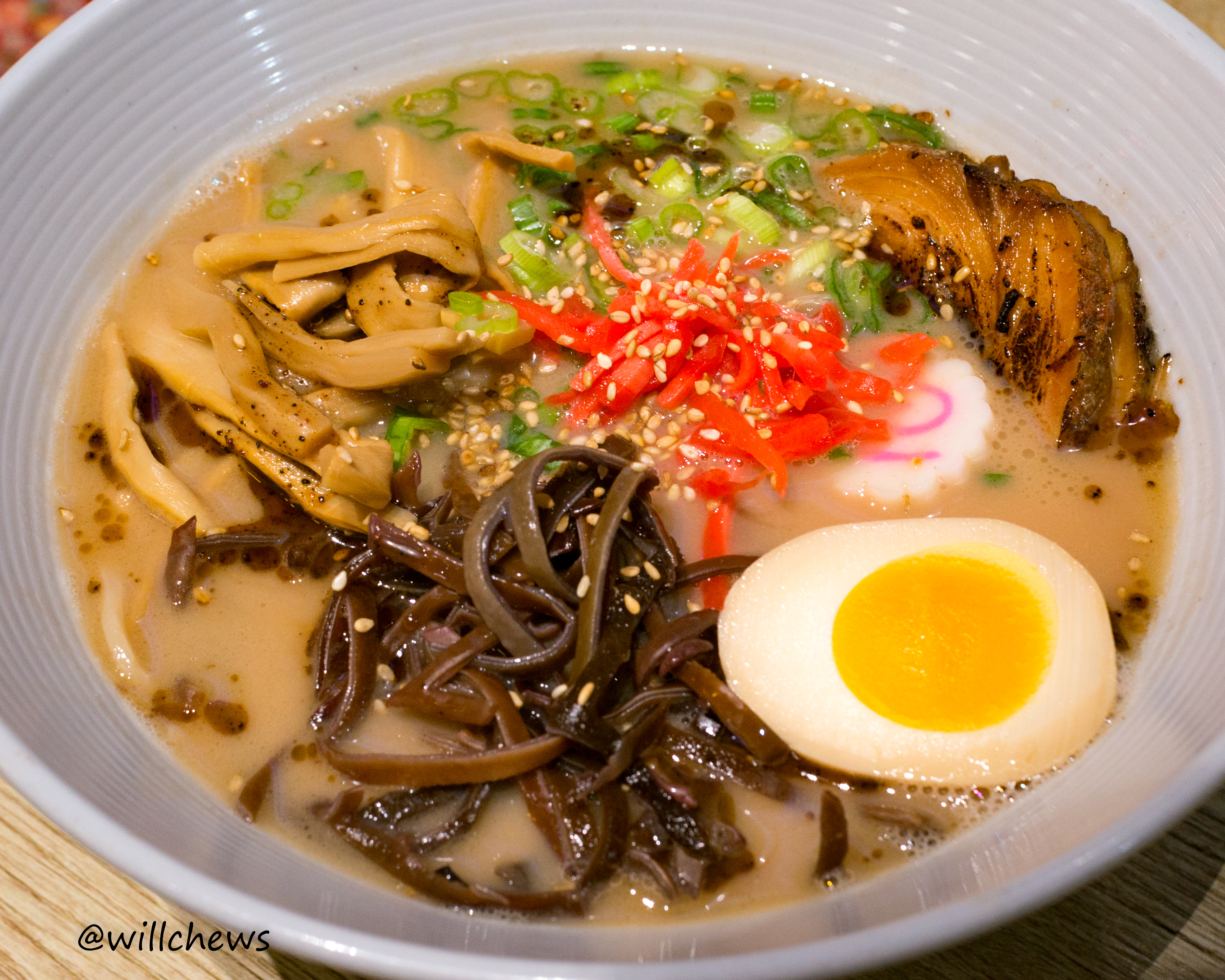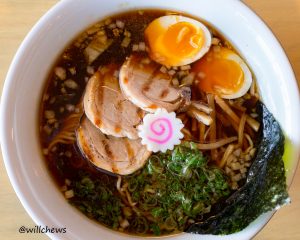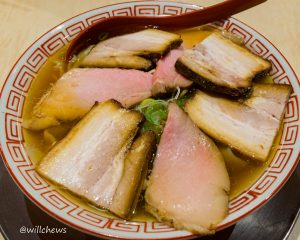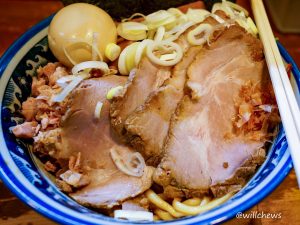Rehoboth Beach is best known as a beach resort town for DC folks; or for those with a modicum of interest in food, the home of Dogfish Head’s original brewpub. It’s not where you would expect to see a ramen restaurant, but Miyagi Ramen Bar has been serving ramen there since 2017. The shop came up when I was searching for ramen shops I could visit on my way home to DC after getting off the Cape May-Lewes Ferry, but what solidified my decision (and not visit the Dogfish Head brewpub instead) was news that one of the owners, Jeong Kim, hand-makes all the noodles in the shop. While this is no guarantee of quality, it does entail a degree of dedication that bodes well for its quality.
Miyagi’s signature ramen is its Black Garlic Tonkotsu Ramen, which I was initially antsy about ordering since tonkotsu is so ubiquitous in American ramen shops because many use tonkotsu’s richness to cover up inferior ingredients and preparation. My server assured me that it was good and takes 26 hours to prepare, and I’m glad that I followed his recommendation. The tonkotsu broth was quite good, with rich and porky flavors balanced against the garlic notes of the black garlic oil. It did not have any of the telltale punchy notes of kit ramen broth, which is ubiquitous in the US. Tonkotsu ramen will never be my natural go-to ramen, but this is a broth I’d be happy to have again.
I also paid close attention to the fresh, made in-house noodles, which is a relatively rare for most shops since they are more apt to order ramen noodles from the likes of Sun, Kobayashi, and Nishiyama rather than making it themselves or getting them fresh. Sourced noodles can be of good quality–Menya Hosaki used Sun Noodles for a few months when COVID-19 shut down its normal supply from Shimamoto Keizo–but they tend to be the uniformly rubbery or overly crinkled kind you see in many places. This is a function of most American shops selecting noodles based on what’s popular in a supplier’s catalog, creating a vicious circle that limits the variety of noodles in the ramen shop ecosystem, divorced from the actual qualities of a noodle and its suitability for different broths. Miyagi’s noodles had none of the alkali rubberiness or crimping of sourced ramen; instead they had an understated taste to them, with machine-cut, square edges signalling how they were made. They may have been too understated: I thought they were fine but could’ve left a stronger impression with me, perhaps by adding more kansui into the dough to give it more bounce. My server informed me that though MIyagi makes its own noodles, it follows a one-size-fits-all policy where the same noodle is paired with every broth, which I think is an oversight and unfortunate. Each bowl does seem to come with more ramen than is the norm for most ramen shops, so that’s something to bear in mind when working up an appetite.
Other elements of this bowl were a mixed bag. Miyagi’s chashu reflects the current trend of serving slices of roasted pork belly coils that are grilled or blowtorched before serving. The two thick slices I had were generous, but they were overly suffused with shoyu/mirin flavor and had a tendency to break off in to chunks; I speculate that that perhaps the chashu had been overly marinated before roasting. Depending on one’s preferences, the ajitama could also be considered as falling short, since the yolk was more solid than jelly-like, cooked for 30-60 seconds longer than it should have been. It’s far from egregious however, and ajitama yolks are subject to personal preference (though anything other than a jelly-like yolk is wrong and you are a bad person). The menma were good and there was a lot of it without paying extra, so a nice bonus. The kikurage was fine and while I’m not a fan of beni shoga (pickled red ginger), it did complement the tonkotsu broth well. But I have to caveat that I would have a much dimmer view if both toppings appeared in the shoyu bowl–as the menu suggests–because I think they would be poor fits in terms of texture and flavor, respectively.
In summary, Miyagi Ramen Bar serves a fine tonkotsu ramen and makes its noodles in-house. That’s worth a visit alone, and the shortfalls in the chashu are not enough of a deterrence. I hope they don’t give up making their noodles in-house, but rather continue to diversify the types of noodles they make as well as improving the recipe. I would not have pegged Rehoboth as home to a good ramen shop, but that may be the reason why Miyagi has tried so hard to succeed.
Q(ueue) Factor/Seatuation: No wait, though Sunday at 19:45 is pushing it in terms of dining-in at Miyagi. Indoor seating, socially distanced, staff wear masks.
Ambiance: Lots of Japanese pop culture images/murals, including a giant totoro painted by the kitchen bunker.
Price: Black Garlic Tonkotsu ($17) + no tax (Delaware!) + tip



